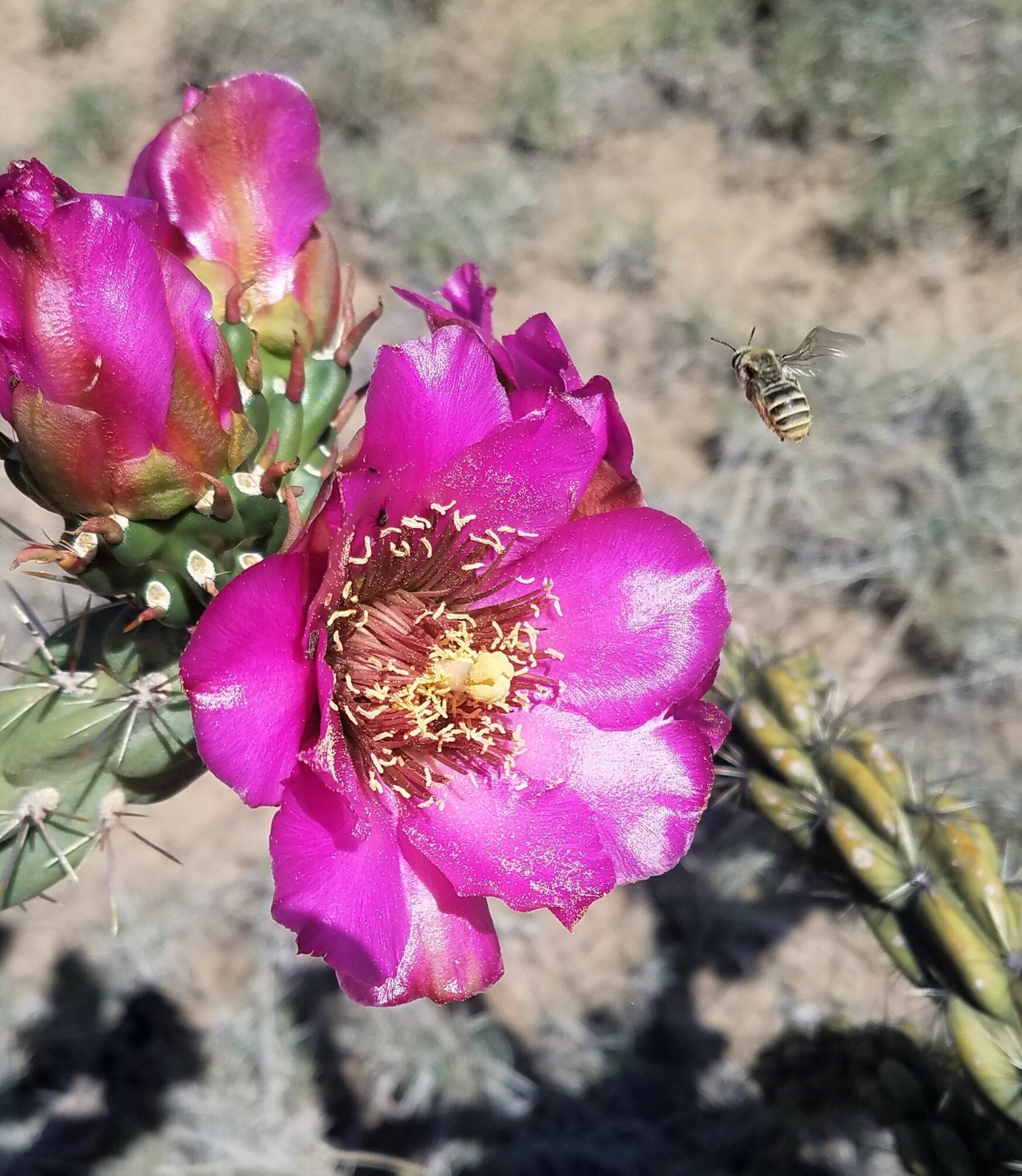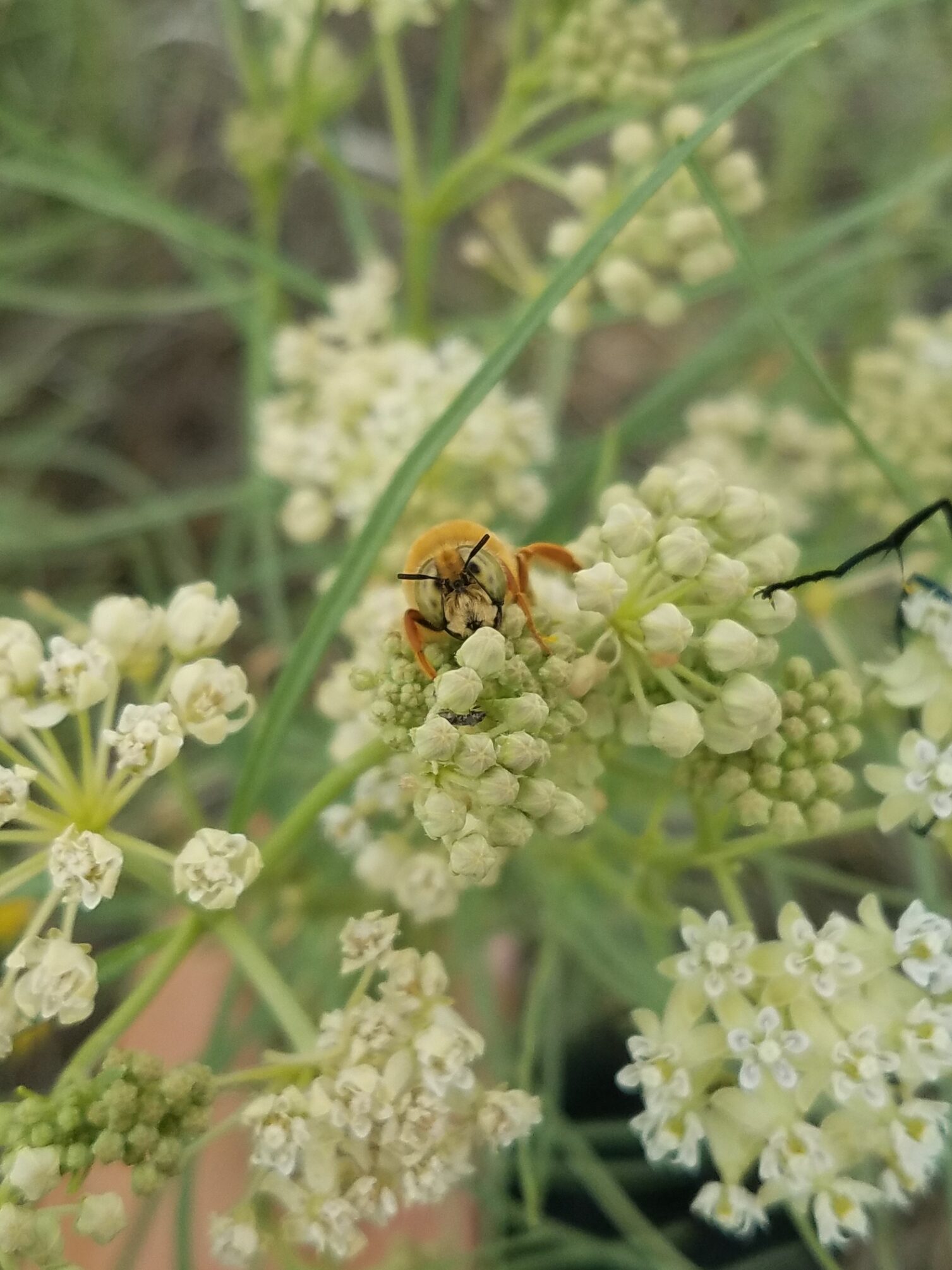
A Diadasia bee hovers over the flower of a Cylindropuntia (cholla) cactus. Photo credit: Jade McLaughlin CC BY-SA 4.0.
Credit: Jade McLaughlin
By Tim Ohlert, PhD Candidate at the University of New Mexico
Between two mountains, surrounded by exposed desert, splashes of purple and red dot the landscape accompanied by a buzz of activity. At this moment, the Chihuahuan Desert is flourishing with plant and insect activity. For a few weeks each year, the desert is teeming with biodiversity, but for most of the year, the landscape is silent and colorless. This part of the Chihuahuan Desert only receives an average of 10 inches of rain per year (~25cm). In summer, temperatures frequently top 100℉ (~38℃) and in winter, temperatures go well below freezing.
Keeping an eye on plants
The sporadic rainfall and dramatic temperature swings in this desert present complex challenges for plants. Winters here are too cool for plants to grow, but summers are also too hot and dry, leaving short windows of only a few weeks in late spring and early fall for plants to work their way through entire growth and reproduction cycles.
To capture the cycles of the desert, the Sevilleta LTER monitors growth, flowering, seeding, and senescence every month. These data are used to study phenology, or the timing of plant life cycles, from pulses of growth after rainfall to flowering and reproduction. Although these data are collected year-round, some changes happen so quickly that even monthly data is too coarse
to capture the landscape’s transformation.
Dr. Alesia Hallmark, a researcher at the National Ecological Observatory Network, uses a network of cameras, known as phenocams, to take pictures every 30 minutes, allowing her to track hour-by-hour, day-to-day, and seasonal patterns of vegetation. Since the Chihuahuan Desert can go from vibrant green to colorless and back in a single day, this high frequency imagery is essential to capture the rapid natural processes of the landscape.
Dr. Hallmark has accumulated millions of unique images of the desert over the past decade. From each image, she can extract information stored in its pixels to calculate how green the desert is at any moment in time. With dozens of images taken each day, she is able to observe how long it takes the desert plants to activate following a rainfall event. The length of time that the desert stays green determines its capacity to provide services such as soil stability and carbon storage, but is also key to the relationships that plants have with other desert-dwelling organisms.
Matching and mismatching

A Svastra bee climbing along Asclepias (milkweed). Photo credit: Jade McLaughlin
Credit: Jade McLaughlin
During the brief windows of time when plants have the necessary resources to grow, animal-pollinated plants must attract as many pollinators as possible to give them a chance to produce seeds for their next generation. Vibrant displays of purple, white, yellow, and red flowers stand out amid the grey and sandy desert, enticing insects to feed on them. In order for plants to succeed, they must perfectly time their flowering with mutualist pollinators. Bloom too early or too late, and plants miss their opportunity to spread their pollen and genes.
Jade McLaughlin is a graduate student at the University of New Mexico and a technician for the Sevilleta LTER. Each month she traps and collects bees to study the seasonality and variability of bee populations at the Sevilleta. The resulting dataset is the longest running native bee monitoring dataset in the U.S. While some bees are generalists and therefore not very particular about which plants they go to for nectar, other bees have tight relationships with the plants that they pollinate. These plants rely on specialist bees to carry their pollen directly to another flower of the same species.
The tighter a plant’s relationship with a specialist bee, the less likely that another bee can fill the role if they become out of sync with their bee partners. Failed coordination between pollinator activity and plant flowering is called ‘mismatching.’ For example, severe drought can alter the timing of plant flowering by forcing plants to flower later in the growing season or even not at all. When this occurs, flowering plants sometimes miss the window of opportunity for pollination. With the Sevilleta pollinator dataset that spans two decades, Jade can find instances of mismatching and determine the causes, whether they be extreme rainfall events or temperature anomalies associated with a warming climate.
Life in the Chihuahuan Desert endures amid extreme temperatures and water scarcity. When the necessary conditions and resources are available, the desert’s inhabitants must make the most of brief periods of time to sustain the region’s biodiversity. Plants and pollinators have evolved a partnership, facilitating their work in tandem, to overcome this harsh environment. The spectacle of color and activity that we enjoy is a reminder of the cooperation needed to survive life in the desert.










